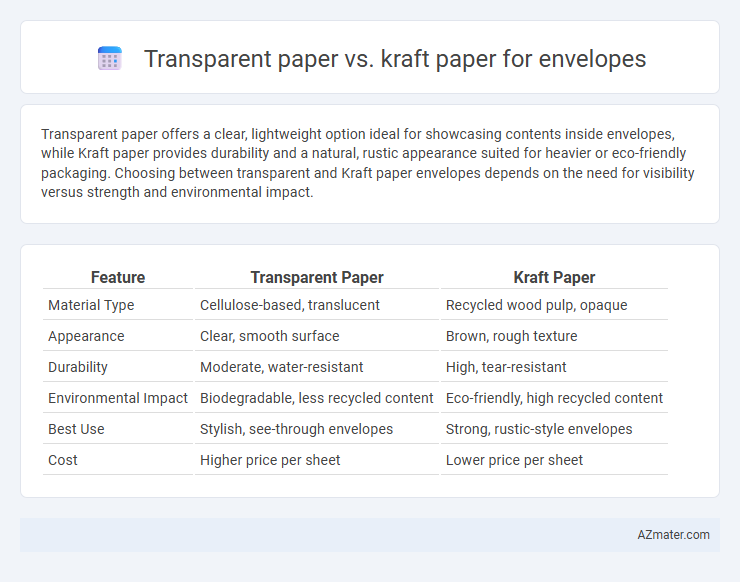Transparent paper offers a clear, lightweight option ideal for showcasing contents inside envelopes, while Kraft paper provides durability and a natural, rustic appearance suited for heavier or eco-friendly packaging. Choosing between transparent and Kraft paper envelopes depends on the need for visibility versus strength and environmental impact.
Table of Comparison
| Feature | Transparent Paper | Kraft Paper |
|---|---|---|
| Material Type | Cellulose-based, translucent | Recycled wood pulp, opaque |
| Appearance | Clear, smooth surface | Brown, rough texture |
| Durability | Moderate, water-resistant | High, tear-resistant |
| Environmental Impact | Biodegradable, less recycled content | Eco-friendly, high recycled content |
| Best Use | Stylish, see-through envelopes | Strong, rustic-style envelopes |
| Cost | Higher price per sheet | Lower price per sheet |
Introduction to Transparent and Kraft Paper Envelopes
Transparent paper envelopes offer high visibility, allowing contents to be partially seen while providing protection, commonly used for invitations or promotional materials. Kraft paper envelopes are made from sturdy, recycled wood pulp, known for durability, eco-friendliness, and a rustic, natural appearance, frequently utilized for mailing documents and packaging. Both materials serve specific purposes based on transparency needs and environmental considerations.
Material Composition: Transparent Paper vs Kraft Paper
Transparent paper, often made from cellulose fibers and treated to achieve translucency, offers a smooth surface ideal for showcasing contents inside an envelope without compromising durability. Kraft paper, composed primarily of wood pulp processed through the kraft process, provides a robust and coarse texture that enhances strength and tear resistance, making it suitable for heavy-duty mailing purposes. The material composition of transparent paper allows for visibility and aesthetic appeal, whereas kraft paper prioritizes sturdiness and protection during transit.
Aesthetic Appeal and Visual Impact
Transparent paper envelopes offer a sleek, modern aesthetic that enhances the visibility of the contents, creating a striking visual impact ideal for invitations or promotional materials. Kraft paper envelopes provide a rustic, natural look that conveys authenticity and eco-friendliness, appealing to brands that emphasize sustainability. Choosing between transparent and kraft paper envelopes depends on the desired brand image and the importance of either showcasing contents or reinforcing environmental values.
Durability and Strength Comparison
Kraft paper envelopes exhibit superior durability and strength compared to transparent paper due to their dense fibers and high tear resistance, making them ideal for heavy-duty mailing. Transparent paper, while visually appealing and moisture-resistant, tends to be more delicate and prone to creasing or tearing under stress. The inherent robustness of Kraft paper ensures better protection and longevity for contents during transit, especially for bulky or heavier items.
Customization and Printing Capabilities
Transparent paper offers superior customization and printing capabilities with its smooth, non-porous surface that allows for sharp, vibrant ink adhesion, ideal for detailed logos and colorful designs. Kraft paper, while less ideal for high-resolution prints due to its rough texture and absorbent nature, excels in rustic or eco-friendly branding with customizable options like stamped logos and natural fiber finishes. Both materials support variable printing technologies, but transparent paper is preferred for precision and color fidelity in envelope customization.
Environmental Impact and Sustainability
Transparent paper envelopes often utilize cellulose-based fibers that are biodegradable and compostable, reducing environmental impact compared to plastic alternatives. Kraft paper envelopes are typically made from unbleached, recycled wood pulp, offering high recyclability and a lower carbon footprint due to minimal processing. Both materials support sustainability goals, but kraft paper stands out for its durability and widespread acceptance in paper recycling programs, making it a preferred eco-friendly choice for envelope production.
Cost Effectiveness and Market Availability
Kraft paper envelopes are more cost-effective due to their lower production costs and widespread availability, making them a preferred choice for bulk mailing and packaging. Transparent paper envelopes, while offering a unique aesthetic appeal, tend to be more expensive and less commonly stocked by suppliers, limiting their market availability. The balance between budget constraints and design requirements often dictates the selection between these two envelope materials.
Practical Use Cases for Both Paper Types
Transparent paper offers excellent visibility for items such as invitation cards, photographs, or promotional materials, making it ideal for stylish and modern envelope designs that showcase contents without opening. Kraft paper envelopes provide superior durability and eco-friendly appeal, widely used for mailing documents, merchandise, and bulkier items requiring protection during transit. Practical use cases for transparent paper include artistic packaging and marketing presentations, whereas kraft paper suits business correspondence, shipping, and archival storage due to its robust nature.
Choosing the Right Envelope for Your Needs
Transparent paper envelopes offer a clear, modern aesthetic ideal for showcasing contents like invitations or promotional materials, while kraft paper envelopes provide durability and a rustic, eco-friendly appeal suited for everyday mailing and packaging. Choosing the right envelope depends on the purpose: transparent paper emphasizes visibility and presentation, whereas kraft paper delivers strength and sustainability. Consider factors such as visibility requirements, protection level, and brand image to determine the optimal envelope material for your specific mailing needs.
Conclusion: Which Envelope Material is Best?
Transparent paper envelopes offer excellent visibility and a sleek, modern appearance ideal for marketing materials or invitations, while Kraft paper envelopes provide superior durability, eco-friendliness, and a natural, rustic aesthetic suitable for documents requiring protection. For long-term use and sustainability, Kraft paper is the best choice due to its strength and recyclability. Transparent paper is optimal for presentation and branding where content visibility is key.

Infographic: Transparent paper vs Kraft paper for Envelope
 azmater.com
azmater.com